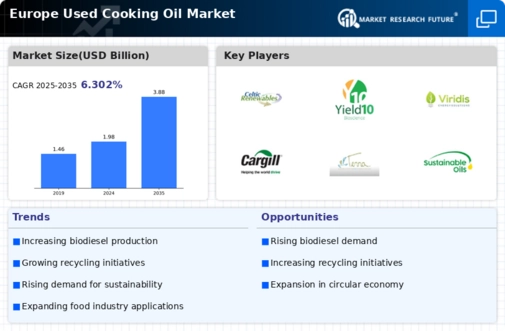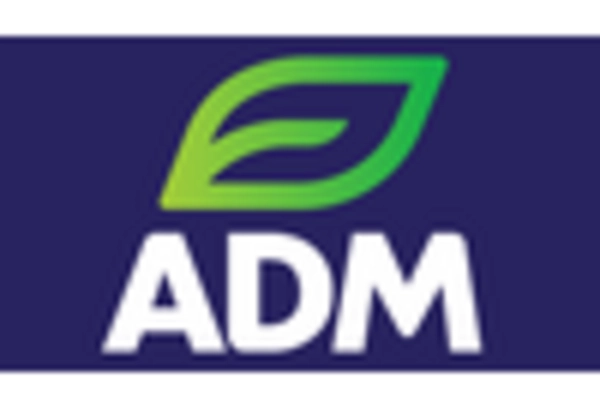Regulatory Support for Waste Management
The used cooking-oil market in Europe benefits from increasing regulatory support aimed at enhancing waste management practices. Governments are implementing stringent regulations to promote the recycling of waste oils, which is seen as a critical step towards achieving sustainability goals. For instance, the European Union has set ambitious targets for waste reduction, which includes the recycling of used cooking oils. This regulatory framework not only encourages businesses to adopt better waste management practices but also creates a favorable environment for the growth of the used cooking-oil market. As a result, companies are more likely to invest in technologies and processes that facilitate the collection and processing of used cooking oils, thereby expanding the market. Furthermore, compliance with these regulations can lead to financial incentives, further driving market growth.
Rising Demand for Renewable Energy Sources
The used cooking-oil market is experiencing a surge in demand due to the increasing interest in renewable energy sources across Europe. As countries strive to meet their renewable energy targets, used cooking oil is being recognized as a viable feedstock for biodiesel production. In 2025, it is estimated that the demand for biodiesel derived from used cooking oils could account for approximately 20% of the total biodiesel market in Europe. This shift towards renewable energy not only supports environmental sustainability but also reduces dependency on fossil fuels. Consequently, the used cooking-oil market is likely to see significant growth as more companies and governments invest in infrastructure to process and utilize waste oils for energy production. This trend is expected to create new opportunities for businesses involved in the collection and processing of used cooking oils.
Technological Innovations in Oil Processing
The used cooking-oil market is poised for growth due to ongoing technological innovations in oil processing. Advances in extraction and purification technologies are making it more efficient to convert used cooking oils into high-quality biodiesel. For instance, new enzymatic processes are being developed that can significantly reduce the energy required for oil processing, thereby lowering production costs. This is particularly relevant in Europe, where the market for biodiesel is expanding rapidly. In 2025, it is projected that the efficiency gains from these technological advancements could lead to a 15% reduction in production costs for biodiesel derived from used cooking oils. As a result, companies in the used cooking-oil market are likely to invest in these technologies to enhance their competitiveness and meet the growing demand for sustainable energy solutions.
Consumer Awareness and Eco-Friendly Practices
The used cooking-oil market is increasingly influenced by rising consumer awareness regarding eco-friendly practices. As consumers become more conscious of their environmental impact, there is a growing preference for products that utilize recycled materials, including biodiesel made from used cooking oils. This shift in consumer behavior is prompting manufacturers to seek sustainable alternatives, thereby driving demand for used cooking oils. In recent surveys, approximately 65% of European consumers indicated a willingness to pay a premium for products that are environmentally friendly. This trend is likely to encourage more businesses to engage in the used cooking-oil market, as they adapt their offerings to align with consumer preferences. Additionally, educational campaigns promoting the benefits of recycling used cooking oils are further enhancing public interest, which could lead to increased collection and processing activities in the market.
Economic Incentives for Recycling Initiatives
The used cooking-oil market is significantly impacted by economic incentives aimed at promoting recycling initiatives. Various European governments are introducing financial support mechanisms, such as subsidies and tax breaks, to encourage businesses to recycle used cooking oils. These incentives not only lower the operational costs associated with recycling but also enhance the profitability of companies involved in the used cooking-oil market. For example, it is estimated that businesses that participate in recycling programs could see a 10% increase in profit margins due to reduced waste disposal costs and additional revenue from selling processed oils. This economic support is likely to stimulate market growth, as more companies recognize the financial benefits of engaging in sustainable practices. Consequently, the used cooking-oil market is expected to expand as businesses capitalize on these opportunities.


















Leave a Comment